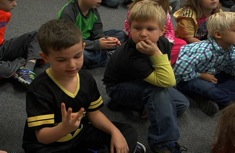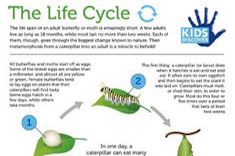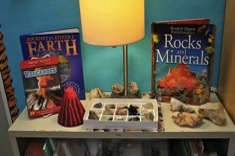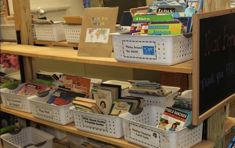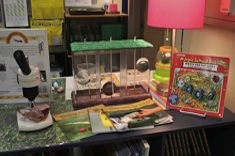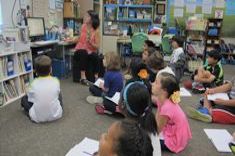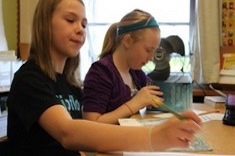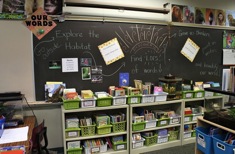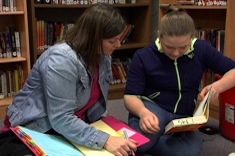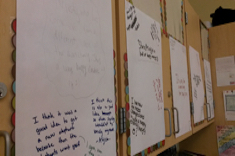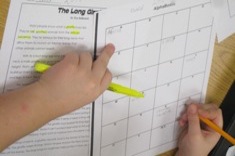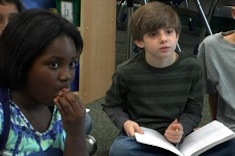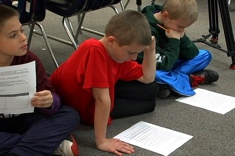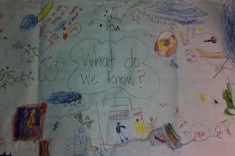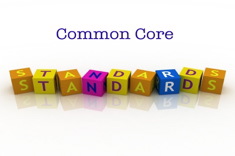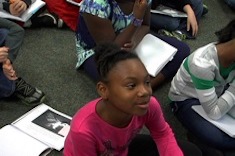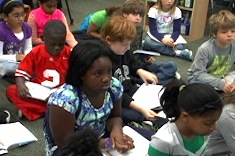Content Literacy
Reading and writing across the curriculum is sparking more interest than ever among teachers and school leaders. Here are the resources you need to build more writing into your math curriculum, more reading and talk into your science program, and especially, how to infuse more nonfiction texts into your teaching throughout the school day.
Latest Content
First-Grade Math Lesson: Concept Practice and Conclusion
Danielle French's first graders continue to test out new math concepts and language in the conclusion of this lesson series.
Infographics and the Common Core: Resources and Standards
Andrea Smith explains why infographics are more useful than ever in the age of the Common Core, and provides many links to free infographic resources on the web.
First-Grade Math Lesson: Practice and Discussion
Students practice creating equations and using new vocabulary in the second installment of a math lesson from Danielle French’s first-grade classroom.
Webquests with Middle School Students
Megan Ginther revisits a classic internet research project.
Classroom Displays for Nonfiction Learning
Andrea Smith shares some of her favorite nonfiction classroom displays.
Exploring Literary Nonfiction with Middle School Students
Holly Mueller and her middle school students have fun exploring the creative aspects of literary nonfiction.
Science Observations in Kindergarten
Mandy Robek helps her kindergarten students complete science observations.
Explore: Time for Nonfiction
Andrea Smith uses Explore Time with her fourth graders to build interest in nonfiction.
Philanthropy and Literacy in Eighth Grade
Beth Honeycutt and Rita Schaeffer introduce a reading and writing activity to their eighth-grade students designed to help them understand philanthropy, using a video to enhance the lesson.
Infusing Informational Texts into Morning Meetings: Fact of the Day and Daily News Routines
Andrea Smith explains two routines, Daily News and Fact of the Day, which are key components of her morning meetings.
Shorter Research Projects: Rethinking Notetaking Strategies
Katherine Sokolowski is assigning shorter research projects in her fifth-grade classroom as a way to help students acquire notetaking skills and understand the boundaries of plagiarism.
Helping Allison Redesign Her Classroom Nonfiction Library
Andrea Smith shares her best advice for library design that celebrates nonfiction as much as fiction.
Getting to Know You: Brown Bag Objects
Maria Caplin uses a getting-to-know-you activity in the first days of school to jumpstart research reading and writing with her fifth-grade students.
The Information Board: Celebrating Nonfiction Every Day
Andrea Smith builds interest in nonfiction in her fourth-grade classroom community through her constantly changing Information Board.
Nonfiction Book Blitz
Justin Stygles finds a nonfiction book blitz is the perfect unit for closing out the school year.
Home and School, Fiction and Nonfiction: Eighth-Grade Conference
Katie Baydo-Reed confers with an eighth-grade student moving between fiction and nonfiction texts, and gives advice about which books are appropriate for home reading.
Nonfiction Graffiti Walls
Katie Doherty uses nonfiction graffiti walls as a tool for building response skills and community with her sixth-grade students.
Nonfiction and English Language Learners
Stella Villalba has advice about connecting nonfiction, young English language learners, and the Common Core.
Conferring About Word Learning
Sean Moore teaches second grader Mikhail some strategies for learning words in a conference.
Owl Research Word Study
Andrea Smith leads a whole-class discussion of recording new content vocabulary in reading notebooks.
“Article of the Week” Activity in Fourth Grade
Tony Keefer finds that the article-of-the-week activity (adapted from Kelly Gallagher's work) is a good way to integrate short shared texts into his fourth-grade literacy workshop.
Penguins Are Amazing!: Informational Writing Comes Alive in Kindergarten
Can kindergartners do informational writing? Keri Archer finds the answer is yes, as she applies Common Core standards to inquiry work in her classroom.
Common Core Research Shifts
Maria Caplin explains four changes she is making in her fifth-grade classroom with writing instruction because of the Common Core.
Whole Class Research Planning in 4th Grade
Andrea Smith’s fourth graders brainstorm next steps for their research project on owl habitats, which includes writing a research proposal.
Streamlining Research Check-ins
Gretchen Taylor finds streamlining research check-ins in her middle school classroom is easy to do when she uses a simple online tool to eliminate a mountain of paper.
Rethinking Nonfiction Topic-Based Text Sets
Franki Sibberson concludes her series on redesigning nonfiction sections of classroom libraries in the age of the Common Core.
Exploring Explanatory Moves Writers Use
Jeff Anderson explores the difference between informational and explanatory writing, and what that might mean for teaching craft moves to students.
Research Book Clubs for Struggling Readers
Beth Lawson finds that a nonfiction research book club is just the grouping structure needed for a group of struggling readers in her fourth-grade classroom.
Whole-Class Research Planning
Andrea Smith leads her fourth graders through brainstorming for their owl research project.
Chris Lehman on Student Research (PODCAST)
Franki Sibberson chats with Chris Lehman (author of Energize Research Reading and Writing) about how the Common Core is changing the ways teachers approach student research in their classrooms.
Browse Content By
Type
Category
- Assessment Tools
- Big Fresh Archives
- Booklists
- Choice Numeracy
- Classroom Design
- Common Core
- Community Building
- Conferring
- Content Literacy
- Digital Literacy
- English Language Learners
- Equity
- Family Relations
- Free Samples
- Guiding Groups
- Leadership
- Literacy Coaches
- Mentor Texts
- Minilessons
- New Teacher Mentors
- Podcasts
- Poetry
- Quote Collections
- Reading Strategies
- Self Care
- Struggling and Striving Learners
- Talking and Listening
- Teacher Study Groups
- Teaching Reading
- Teaching Writing
- Word Study and Vocabulary
Author
- Melissa Quimby
- Nawal Qarooni
- Gwen Blumberg
- Julie Cox
- The Lead Learners
- Hannah Tills
- Josie Stewart
- Ruth Metcalfe
- Mallory Messenger
- Becca Burk
- Jodie Bailey
- Vivian Chen
- Mary Brower
- Tiffany Abbott Fuller
- Stephanie Affinito
- Ruth Ayres
- Leigh Anne Eck
- Heather Fisher
- Shari Frost
- Julie Johnson
- Suzy Kaback
- Gigi McAllister
- Shirl McPhillips
- Melanie Meehan
- Cathy Mere
- Debbie Miller
- Tara Barnett and Kate Mills
- Tammy Mulligan
- Dana Murphy
- Bitsy Parks
- David Pittman
- Brenda Power
- Heather Rader
- Matt Renwick
- Mandy Robek
- Christy Rush-Levine
- Gretchen Schroeder
- Jen Schwanke
- Brian Sepe
- Katherine Sokolowski
- Stella Villalba
- Jennifer Vincent
Grade Level
Choice Literacy Membership
Articles
Get full access to all Choice Literacy article content
Videos
Get full access to all Choice Literacy video content
Courses
Access Choice Literacy course curriculum and training

